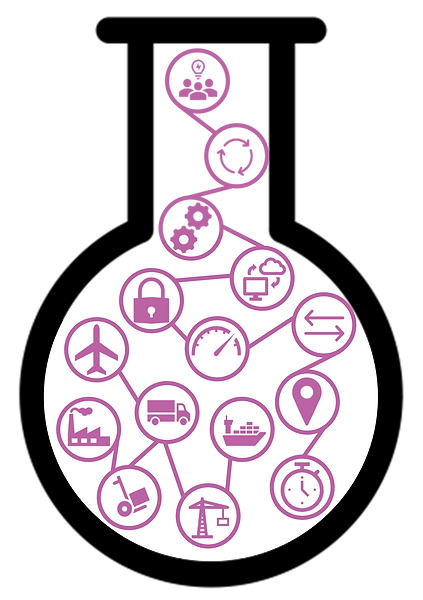My Journey to the CSCP Certification
- Gloria Isamar Rivera
- Jan 25, 2021
- 8 min read

On December 30, 2020, I took the CSCP exam.
Since then, I have received many questions like how I did it, how was it, how prepared I felt I was before taking it, and what advice I could give, among many other questions.
In no time, I was helping and inspiring others, something I have always enjoyed doing.
--- --- --- --- --- --- --- --- --- --- --- --- --- --- --- --- --- --- --- --- --- --- --- --- --- --- --- --- --- --- --- --- --- --- --- --- --- --- --- ---
In this post, I share my CSCP learning process and how I passed the exam certification on my first attempt.
--- --- --- --- --- --- --- --- --- --- --- --- --- --- --- --- --- --- --- --- --- --- --- --- --- --- --- --- --- --- --- --- --- --- --- --- --- --- --- ---
If you are exploring the idea of becoming a CSCP holder, it is my intention to motivate you and bring some relief. First, let me clarify that you can have a job, have kids, and have a life. YES, YOU CAN.
But before committing, know that this takes time. Consider the following,
There is a different pace for every person. Know YOUR limits and adjust as needed.
This certification is not easy; it is not obtained by showing up to classes, making a presentation, or a project. It is necessary to read, analyze, and understand the terms, which leads me to the next point...
Your knowledge MUST BE strong and flexible; you will need to know how to apply the terms to hypothetical situations.
Let's jump right into it!
Why the CSCP?
I decided to get certified under APICS / ASCM because it is a worldwide leading organization in Supply Chain. After researching, I found that the CSCP could give me a broader view of the supply chain, all the processes, and the technology applications used today to keep the continuous flow of goods, information, and cash.
It was also an excellent opportunity to expand my professional network and be a part of a vast and forward-looking community.
Starting point
I started with the membership and the Learning System.
There are different memberships and learning options; choose one that aligns best with your current status.
As I was in self-quarantine at home due to Covid19, I chose the Self-Study Mode.
What Happened Next?
APICS / ASCM shipped 3 Modules (a total of 8 sections, 45 chapters) and provided me with access to the same material in digital format.
I used both formats; it helped to have the material handy on my phone, computer, and a physical book where I made written notes.
The Study Material
ASCM provides you with the right material to get you prepared.
I received my books in April, analyzed the material, and came up with a way to approach it.
There are almost 1K pages of content.

I counted backward to set my time horizon, considering 2 months per module:
October / November for Module 3;
August / September for Module 2;
and June / July for Module 1.
That helped me get organized.
I strongly recommend you to explore all of ASCM tools, including the flash-cards and exercises.
You will have access to the digital platform and digital learning resources for 12 months.
Additional Resources
I got the following:
3 notebooks, one for each module
PostStick Notes and PostStick Flags
highlighters, color markers, and color pens
My Study Routine
Having experience with online learning while working full time made me feel like I would handle this with no significant issues.
I WAS WRONG!
I had to adapt and re-adapt. I had to take breaks (more breaks than I have had arranged). But most importantly, I had to be flexible with the process and with myself.
Some days I started studying very early in the morning, and it worked perfectly. Other days I felt more productive studying at night.
Some days I had coffee, other days I chose tea.
I planned to study on weekdays only, that also changed. As the formal test day approached, I started studying every-single-day, 90min study / 20min break, from 9am to 2pm or 4pm to 9pm.
I wrote notes and made summaries of each chapter. I read some chapters twice. After finishing with a chapter, I took the quiz. Scores under 80% were a red flag for me, and I revisited the material.
After finishing reading all modules and quizzes, something that really helped me connect the dots was to make flowcharts. I started on paper, then switched to a wall with PostStick Notes! By doing this, I was able to link related processes and information from all the 3 modules.
Here's how my study room wall looked like when the exam date was getting closer. Demand / Supply Planning, S&OP, Production Planning, from the aggregate to the item level, the SCOR Model, and some other important things!

Another thing that worked for me was an offset schedule. My test was on 12/30; I arranged all my studies to be completed by 11/30. I used this Excel spreadsheet to measure and keep track of my own progress.

Breaking it down allowed me to distribute my weeks and my study time. Some chapters were more "loaded" than others, so I had to make a few updates. For modules 2 and 3, I decided to adjust to 7 weeks per module (instead of 8 weeks - 2months). That gave me 7 more days to use if I had to re-read, re-do quizzes, or take a break. This change was a good idea!
The Pre-Test, Chapter Quizzes, Section Quizzes, and Post-Test
The Pre-Test gives you an idea of your knowledge related to the material. I took it first. It has 150 questions and leads to a study plan with study recommendations, based on your responses.
The chapter quizzes and section quizzes were an excellent tool to evaluate my knowledge at the granular level.
I took the chapter quiz when I finished each chapter but returned to it a few weeks later to re-evaluate my retention level and term understanding. As I mentioned before, scores under 80% were a red flag for me, and I returned to the material until getting a better score.
All tests and quizzes are multiple-choice (4 options). Each question is confirmed as correct or incorrect individually as soon as you submit your response. You will also see a statement on top of the page confirming why your answer is correct or incorrect.
The Post-Test is very similar to the formal test. You have a timer at the top left corner. It is different from the quizzes and the Pre-Test; responses are not corrected until the end. This allowed me to focus on responding while measuring my timing against the active timer. I "trained" to respond to each question in a minute or less. Some questions required more than 1 minute. That technique helped me prioritize and distribute the available time. You are allowed to flag questions and return to them later.
The Exam Purchase
As soon as you purchase the exam, you have 6 months to set the date and take it.
You can purchase the material and wait until you feel ready to commit to a date.
The Exam
This is a big deal. You will need all your energy, focus, and a clear mind!
There are 150 multiple-choice questions with 3.5 hours to finish.
There is a digital whiteboard for the mathematical calculations, and there is also a digital calculator that can be adjusted from basic to scientific. Also, you can flag questions and return to them at the end. The timer is visible all the time.
Be aware; breaks are not allowed. You can't leave or walk away from the computer. You and your computer are being recorded/monitored with proctoring software.
Any interruption or sound could invalidate your test. Make sure there is total silence.
I have taken other proctored exams in the past; the experience is basically the same.
It requires a previous screening of the area; computer, clear desk, clear walls, all-around visuals without study materials are mandatory to validate the place as a proper one to take the test.
A valid ID is also needed. Depending on your location, you might need other documents.
Verify the check-in instructions and be ready to start 30min before the scheduled time.
I scheduled it for 9am, by 8:20am, I was ready to check-in.
I was nervous, worried, and anxious; I guessed it is normal.
The check-in process took less than 30 minutes. As soon as you submit everything and get the clearance, the exam is released, and you can start.
I flagged less than 20 questions for review and had plenty of time to verify them. All questions were answered.
Even though I got "trained" to respond to each question in a minute or less, I hit the final submit button having only 12 minutes remaining to complete the 3.5 hours.
The Results
You will see if you pass or not as soon as you finish.
A score of 300 or more is needed to pass.
Your computer recording is reviewed, and ASCM re-confirm your certification in the next 24-48 hours. You will receive an email with the notification. A downloadable certificate will be available in your ASCM account as a confirmation of your credentials.
Then download, print, share, and celebrate!
Here's mine, I got notified on 12/31; perfect timing!
What a way to wrap up 2020!
Costs
The obvious question is: How much are you willing to invest in yourself and your career?
In my case, I considered this as an investment, which could validate my expertise related to Supply Chain and open new opportunities for me. Besides, I love to learn, so I decided to go for it!
Here's what I spent:
Membership (valid for 1 year): $110.00
Learning system digital access & books (access for 1 year): $995.00
Exam: $625.50
Plus the cost of notebooks, pens, and post-sticks!
Click here to check actual prices for the learning system and exam at the APICS ASCM portal.
5 Key Factors
Planning; setting a time horizon over my study routine helped me create a path towards this goal.
KPIs; setting and measuring weekly specific targets and milestones kept me aware of my status, and I felt energized to move forward with a clear view ahead.
Consistency; by doing the work I had to do every day, I got closer and closer to the finish line feeling confident.
Flexibility; knowing my limits and being willing to adapt, re-adapt, search for resources, and ask for help if needed to make it happen.
Breathe; allowing myself to take breaks to recharge was rewarding. After all, we are humans.
Looking Back
Having a strong background in logistics, freight, and transportation helped me navigate this material. There were days I felt overwhelmed; sometimes, I thought it was too much to learn to do it alone.
I remember reaching out to some instructors, certified professionals, and other professionals who had plans to take the certification soon.
Not everyone responded to me, but I am forever grateful to those who did.
My CSCP journey took me further away, to where I would've never expected. I've met many professionals (most of them via LinkedIn), who are now part of my professional network. They motivated me to pursue this certification during the COVID19 pandemic, with a 13yo boy at home while he was new to an online school program.
Some days were more complicated and challenging than others.
If you ask me now if I would take the CSCP knowing what I know today, my response is YES.
If you ask me if I would recommend this certification to a professional or a student, my response is DEFINITELY!
If you are thinking about getting certified by APICS / ASCM but are unsure which certification works best for you and your career goals, learn more here.
If you are thinking about committing to pursue the CSCP, I hope this empowers you to go for it.
If you have any questions related to my experience with the CSCP, I can help! Send me a message, and I will get back to you ASAP.
Thank you for reading ✌️!
--- --- --- --- --- --- --- --- --- --- --- --- --- --- --- --- --- --- --- --- --- --- --- --- --- --- --- --- --- --- --- --- --- --- --- --- --- --- --- ---
🔗 Remember to follow this blog on Instagram @MyLogisticsLab & our content #LogisticsAreEverywhere on Instagram and LinkedIn.
🎥 Discover us on YouTube, using #LogisticsAreEverywhere, and subscribe 🔔!
📌 Have a topic to suggest, questions, or comments? Feel free to contact me. Please send me an email with more details MyLogisticsLab@gmail.com or reach me via social media (Facebook | Instagram | LinkedIn).























Commenti